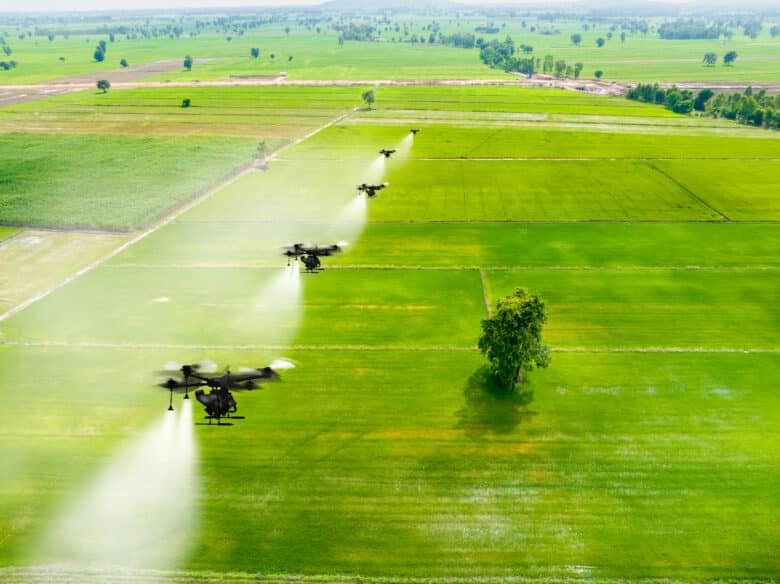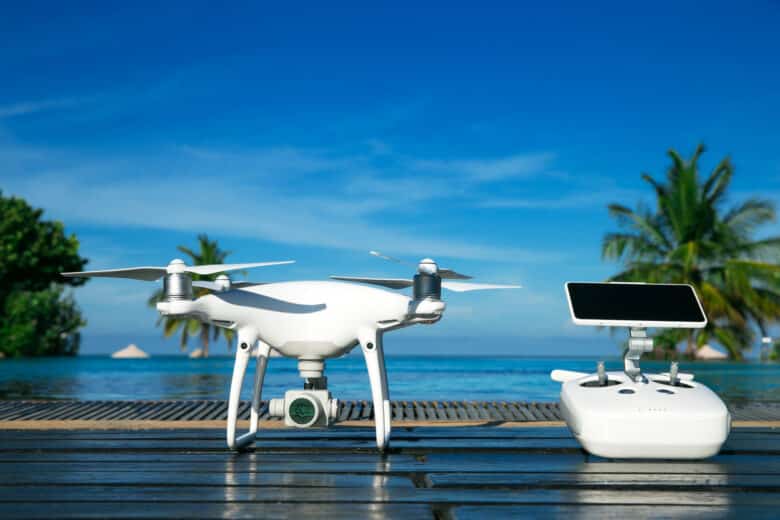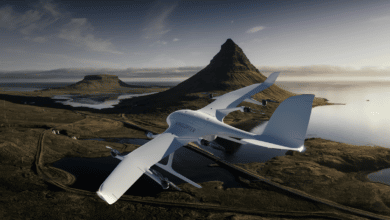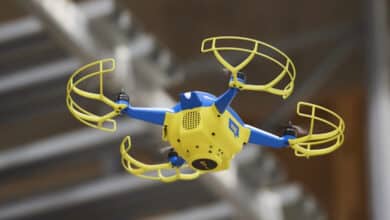
Drones are becoming increasingly popular, whether for leisure activities, photography, video production or professional applications such as mapping and surveillance. This buying guide is designed to help you find the right drone for your needs. We also want to inform you about the legal framework and necessary requirements such as a drone license.
Types of drones
Not all drones are the same. If you decide to buy this fun and sometimes helpful flying object, you should first know which drone is right for you. Over time, different price ranges and categories have emerged. For a better overview, we have made an attempt to differentiate between the drones.
Leisure and toy drones
- Price: 20 – 200 euros
- Suitability: Ideal for beginners and children
- Range: 10 – 100 meters
- Flight time: 5 – 20 minutes
- Features: Simple controls, basic cameras
Camera drones for amateur photographers
- Price: 200 – 1.000 Euro
- Suitability: Ideal for amateur photographers and filmmakers
- Range: 500 meters – 2 kilometers
- Flight time: 15 – 30 minutes
- Features: High-quality cameras (FHD, 4K), GPS, image stabilization
Professional camera drones
- Price: 1,000 – 5,000 euros and more
- Suitability: For professional photographers and filmmakers
- Range: Up to 7 kilometers
- Flight time: 25 – 40 minutes
- Features: High-performance cameras (4K, 6K), advanced stabilization systems, numerous sensors
- Sensors
Racing drones
- Price: 100 – 1,000 euros
- Suitability: For drone racing and FPV (First Person View)
- Range: 500 meters – 2 kilometers
- Flight time: 5 – 10 minutes (optimized for speed)
- Features: FPV camera, high speed and maneuverability
Industrial drones
- Price: 5,000 euros and more
- Suitability: Professional applications (agriculture, inspection, surveillance)
- Range: Up to 10 kilometers
- Flight time: 30 – 60 minutes
- Features: Specialized sensors (thermal imaging cameras, multispectral sensors), robust construction
Important features and specifications of drones
There are also some major differences between the various types of drone. These affect important parameters of the small flying object. In the following, we will explain which features you should look out for when making a purchase.
Camera quality
Drones can shoot some breathtaking video footage. However, the camera quality is a prerequisite for a great end result. How good this ultimately is depends on various factors. Firstly, there is the resolution. If you want reasonably usable recordings, you should make sure that the camera offers at least Full HD (1,920 x 1,080 pixels).
Of course, a resolution of 4K is even better. Professional drones now even offer 6K resolution. However, the high resolution usually comes at a high price. On top of that, the high-resolution recordings eat up storage space. When we talk about camera quality, the frames per second (fps) also play a major role.
If you want to create the most natural moving images possible, you should definitely go for 60 fps. A combination of high resolution and many fps is usually associated with a high price. Medium-priced devices, on the other hand, give you the choice between high resolution or many fps. Another important point is image stabilization.
Drones use different techniques to prevent blurred images. For example, some rely on an electronic image stabilizer (EIS). In combination with this, the camera is often mounted in a gimbal system. Here, even breathtaking flight maneuvers do not cause blurred images. In the case of larger, high-priced drones, this may well be a structure consisting of three connected gimbals.
Flight time and battery life
Flight and battery life should not be underestimated. This is at least the case if you want to use the drone for longer recordings or fun races. There are sometimes huge differences in this area. The battery life between different drones can range from 5 to 60 minutes.

But if you want a long-lasting drone, you have to be willing to compromise. As a long-lasting battery always requires a lot of space, drones with a long battery life are usually correspondingly large and heavy. Here you have to weigh up whether compact dimensions or a long-lasting battery are more important.
Range and control range
There are also significant differences in the range and control range of drones. This feature is particularly important for professional users. Mid-range drones usually offer a range of up to 5 km. However, if you opt for a better equipped model from the upper class, it can also be a whopping 15 km.
Basically, you can say that a long range is always reflected in a higher price. However, when talking about the range of a drone, the control range is also important. This refers to the distance up to which the drone can be controlled using a smartphone or controller. The magic upper limit here is usually 1.5 km.
Technically, a greater distance between the drone pilot and the drone would certainly be possible. However, it is a legal requirement that the pilot must always have a line of sight to the flying object in order to minimize the risk of an unintentional accident. To ensure the best possible control, drone users should always keep the distance to the drone as short as possible anyway.
GPS and autonomous flight functions
Many drones have a GPS module on board as standard. However, there are also many models, especially compact ones, that do not offer GPS. But why do you need it at all? Without GPS, some features that are essential for many drone experts are lost. For example, the automatic return or return to home function.
Here, the drone automatically flies back to the starting point at the touch of a button. Of course, it would not be able to do this without a GPS module. After all, the function requires localization. This is practical if you lose sight of the drone and want to end the flight. It also saves you having to fly back manually.
However, autonomous flight functions are also possible with a drone without GPS. For example, the Follow Me mode. Here, the camera first focuses on a target and then follows it. The HoverAir X1 (€ 539.00 * at Amazon), for example, proved how well this works in our test. Although there is no GPS module on board here either, the mini drone offers various autonomous flight functions.
Safety functions
Anyone who dares to fly a drone should not take it lightly. After all, there is a safety risk inherent in flying objects. Incorrect movement or a defect can lead to a crash, which can result in damage to property and, in the worst case, injury to people. To keep the risks as low as possible, however, manufacturers rely on various safety functions. These include comprehensive obstacle detection, for example.

This prevents the flying object from colliding with people or objects in an uncontrolled manner. Many models also offer an automatic emergency landing. Here, for example, the drone automatically starts to land when the battery is running low. As a general rule, the larger the drone, the more important the safety functions. After all, size and weight play a major role in the potential damage a drone can cause.
Additional accessories
Last but not least, you should pay attention to the scope of delivery. After all, there are wearing parts on a drone that will need to be replaced at some point. This results in follow-up costs that you should keep in mind. Good basic equipment is the be-all and end-all if you want to avoid the hassle of buying new parts as late as possible.
Spare propellers or additional batteries are helpful. The latter also make it easy to extend the drone’s runtime. What you should also get is a suitable carrying bag. This simply makes it easier to take the drone with you and usually not only offers space for the flying object, but also the right accessories.
Legal framework conditions for drones
Drone flights are a lot of fun. That much is certain. But you shouldn’t be too hasty in ordering your own flying object and taking off. After all, there are some legal framework conditions and requirements that hobby or even professional drone pilots should definitely keep in mind.
Drone license
As soon as a drone weighs 250 g or more, a drone pilot’s license or certificate of competence is essential. A distinction is made between the small and the large drone license. We have summarized the most important information on the two certificates of competence. If you need more details, you can take a look at the relevant FAQ from ADAC.
Small drone license (certificate of competence A1/A3)
- For drones between 250 g and 25 kg (drone class C3 or C4)
- Prerequisite: Minimum age 16 years
- Exam: Online theory test at a body recognized by the German Federal Aviation Authority (LBA)
- Contents: Basic knowledge of aviation law, meteorology and navigation
Major drone license (remote pilot certificate A2)
- For drones weighing 25 kg or more (drone class C2)
- Prerequisite: Minimum age 16 years
- Test: Theoretical test at a test center recognized by the LBA, practical proof
- Contents: Advanced knowledge in the areas of law, meteorology, flight performance and human factors
Obligation to register
If flying a drone requires a drone license, the drone must also be registered. This means that registration is mandatory for drones weighing 250 g or more. The Federal Aviation Office (LBA) is the addressee for registration. As a result, the owner receives a registration number, which then serves as a kind of license plate. This must be visibly attached to the drone.
No-fly zones and permits
Drone flights are prohibited in certain areas such as near airports, nature reserves, over crowds and in residential areas without a permit. Accordingly, you must obtain a corresponding permit for such flights. Regardless of where the drone is flown, a permit is also required above a certain flight altitude. If the drone flies higher than 120 m, the flight also requires a permit.
Insurance
Liability insurance for drones is mandatory in Germany. This covers damage that may be caused by the operation of the drone.
Tips for buying drones
- Define the area of use: Think in advance about what you want to use the drone for (leisure, photography, professional applications).
- Set a budget: Set a budget that you are willing to spend on your drone. This will allow you to narrow down the range of possible drones that are eligible for purchase.
- Read reviews and test reports: You can find many reviews of drones on the internet. However, if possible, you should not just read one test report. It is best to take a look at several reviews to get an overall picture that is as neutral as possible.
- Take accessories into account: Pay attention to the accessories included in the scope of delivery and possible additional purchases. Things like bags, additional batteries and more can significantly increase the cost of a drone.
- Comply with legal requirements: Make sure you meet all legal requirements such as registration and insurance.
Conclusion
Buying a drone requires careful consideration and planning. By understanding the different types of drones and the legal framework, you can make an informed decision and ensure that you will enjoy the flying object for many years to come.






